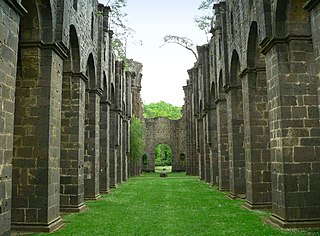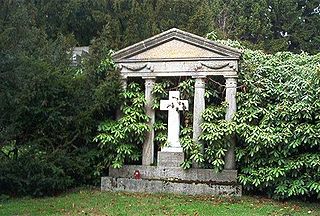 W
WArnsburg Abbey is a former Cistercian monastery near Lich in the Wetterau, Hesse, Germany. It was founded by monks from Eberbach Abbey in 1174. Although heavily damaged in the Thirty Years' War it was rebuilt later in the 17th century and prospered in the 18th century, when much of the abbey was rebuilt in Baroque style.
 W
WThe Becklingen War Cemetery is a military cemetery located in the state of Lower Saxony in north Germany on the Lüneburg Heath. It was built by the Commonwealth War Graves Commission who continue to look after it today. The cemetery lies near Getrudenhof near the village of Becklingen and just north of the British Army base of Hohne Station where the Headquarters of 7th Armoured Brigade and several brigade units were based until 2015, when the brigade moved back to the UK.
 W
WThe Berlin 1939–1945 War Cemetery is one of two Commonwealth War Graves Commission (CWGC) cemeteries in Berlin, the other being the World War I Berlin South-Western Cemetery in Stahnsdorf, Brandenburg. The Berlin 1939–1945 War Cemetery was established in 1945 as a central burial ground for aircrew and prisoners of war who were interred in the Berlin area and in East Germany. There are also 260 burials from the post-war British Occupation Authorities staff, or their relatives. Of the wartime burials, about 80% are aircrew, killed in action over Germany: the remainder are prisoners of war.
 W
WThe Bitburg controversy preceded and followed a ceremonial visit by U.S. President Ronald Reagan to a German military cemetery in Bitburg, a town in extreme western Germany, in May 1985, designed to commemorate the end of World War II in Europe 40 years earlier. The visit aroused considerable criticism in the United States and around the world, when it became known that of the nearly 2,000 German soldiers buried there, 49 were soldiers of the Waffen-SS, the military arm of Nazi Germany's SS (Schutzstaffel). The entire SS was judged to be a criminal organisation at the Nuremberg trials. The fact that Reagan had not been scheduled to visit former Nazi concentration-camp sites compounded the controversy, and a trip to Bergen-Belsen concentration camp was later added to his itinerary.
 W
WThe Golm War Cemetery is a World War II cemetery near the village of Kamminke close to the German-Polish border on the island of Usedom maintained and managed by the German War Graves Commission. The cemetery is the largest war cemetery in Mecklenburg-Vorpommern and one of the largest in Germany.
 W
WHamburg Commonwealth War Graves Commission Cemetery is a war cemetery which was built and is looked after by the Commonwealth War Graves Commission (CWGC). The war graves of 676 Commonwealth service personnel from World War I and 1,889 from World War II are located near Chapel 12 in the greater Ohlsdorf Cemetery in the Ohlsdorf quarter of Hamburg.
 W
WOhlsdorf Cemetery in the Ohlsdorf quarter of the city of Hamburg, Germany, is the biggest rural cemetery in the world and the fourth-largest cemetery in the world. Most of the people buried at the cemetery are civilians, but there is also a large number of victims of war from various nations. The cemetery notably includes the Old Hamburg Memorial Cemetery with the graves of many notable Hamburg citizens.